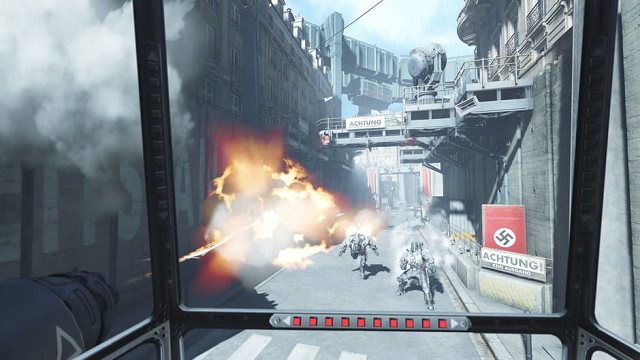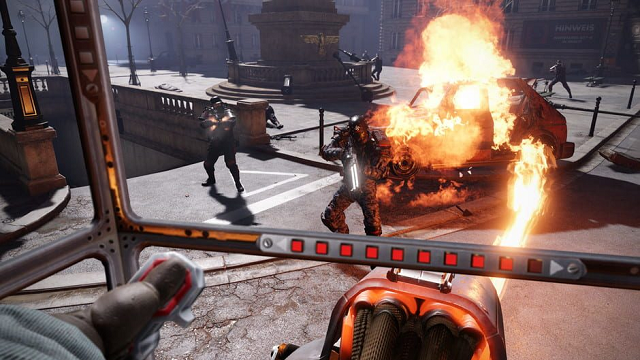Set in 1980’s Paris, Wolfenstein: Cyberpilot is a virtual reality spin-off from the main series of Wolfenstein games. You take control of a nameless, mute character referred to only as ‘Cyberpilot’. Obeying instructions from a French ally, you hack your way into various Nazi killing machines to turn them into Nazi-killing machines, a joke at which the game whimsically rolls its proverbial eyes.
The only explanation for Wolfenstein: Cyberpilot being an entirely seated experience is provided by a female voice, which tells you that “they” have had to strap you into a chair. There’s no explanation why.
Of course, this contrivance feels like a missed opportunity at building a worthwhile backstory. For example, you might have been left wheelchair-bound by a tragic accident or an experiment, or maybe you were left mute after a Nazi soldier tried to slit your throat.
It’s a common and ironic sin in VR games, which are usually so focused on player immersion that they don’t spend any time fleshing out the world itself. It’s particularly vexing and disappointing here because Wolfenstein has such rich and interesting lore — but Cyberpilot only ever briefly references it.
Utilizing VR, the game does a fantastic job immersing you in its setting, but that presents its own issues, too. You never feel like you’re in danger because you aren’t the one directly in the fight. Your character is quite clearly controlling the robots remotely while viewing a live video feed, as opposed to actually piloting mechs and machines, which leaves everything feeling a bit flat and detached.

Add to this that enemies don’t make any sounds when you shoot, burn, or otherwise injure them, and you end up feeling incredibly disconnected from Cyberpilot‘s gameplay. You end up with an experience that doesn’t feel like a Wolfenstein title. There’s no blood. There’s no real feeling of conflict. And Nazis comically ragdoll when you kill them.
A number of mechanics also detract from any enjoyment you’d get out of making Nazi marshmallows, such as the game’s self-healing button. Having a way to heal yourself is fine, but the action of engaging it takes five seconds or so, meaning you’re stationary and unable to access your weapons. When this happens every 30 seconds, it starts to become a chore, and I’m not sure why Bethesda wouldn’t just give you regenerating health or provide some other time-saving mechanic.
Death can also mean 5-10 seconds of loading screens, each manifested as lines of hacker code. Of course, you have to sit through these before you regain control of your machine, which, again, becomes exhausting after a fashion.
There are certainly positives to Wolfenstein: Cyberpilot’s gameplay, though, even if they’re somewhat buried under the bloat.
There’s a hacking minigame that functions a lot like Bethesda’s classic lock-picking puzzle, only in three dimensions; by rotating the left move controller in 3D space, you look for “sweetspots,” which feels unique and rewarding.
Combat in the final robot you pilot, the Zitadelle, also packs an enjoyable punch.

Despite its flaws, there’s a good amount of polish and versatility built into Wolfenstein: Cyberpilot as well. There are three difficulties for those that like a challenge, there achievements to collect, and there is a wide variety of comfort and performance options to tweak in the menu.
The game only lasts a couple of hours, and the levels are linear, but there have been far worse VR titles to release for $20.
Pros
- Good level of polish and options
- Clever controls make for some interesting mechanics
Cons
- Gameplay is stale and flat overall
- Barely utilizes the Wolfenstein brand
- Short and forgettable
Wolfenstein: Cyberpilot feels more like an elongated tech-demo than a fully-fledged VR title. It only features a handful of levels, which don’t leave much room for exploration. I’m glad Bethesda didn’t decide to build another wave shooter — that’s the last thing VR needs! — but Cyberpilot’s shallow shooting gallery leaves much to be desired.
Wolfenstein: Cyberpilot supports the Dualshock 4 and Move controllers on the PS4, and is also available on Steam. It officially supports the HTC Vive, WMR, and Valve Index headsets, but we had no issue playing it with an Oculus Rift S.
[Note: A copy of Wolfenstein: Cyberpilot was provided by Bethesda for the purpose of this review.]







Published: Jul 26, 2019 06:29 am